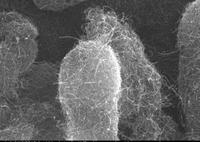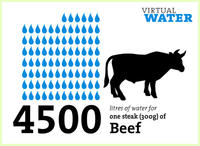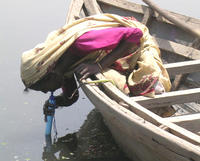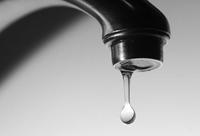-
Nanotechnology to help purify water

Among many potential applications, carbon nanotubes are great candidate materials for cleaning polluted water; many water pollutants have very high affinity for carbon nanotubes and pollutants could be removed from contaminated water by filters made of this nanomaterial — for example, water soluble drugs which can hardly be separated from water by activated carbon
-
-
Majority of water in Mumbai unsafe to drink
In May 2011 researchers found that one in ten water samples collected in locations across Mumbai, India were unsafe to drink; in some areas 40 percent of the samples collected were contaminated; most alarming was the fact that thirty-six of the water samples tested positive for E.coli bacteria; the local water utility has refused to acknowledge the problem
-
-
New tool predicts drought
Knowing when to instigate water saving measures in dry times will be easier from now on, following a breakthrough in drought prediction: an Australian researcher has developed a way to predict droughts six months before they begin
-
-
Virtual water would not remedy global fresh water shortage

More than 80 percent of humanity currently lives in regions where water security is threatened, meaning that as the global population grows against a finite volume of freshwater, a more equal distribution of water use between countries will be needed; virtual water — that is, the amount of water it takes to produce goods or a service — has been suggested as a possible solution to this growing problem by using virtual water values to inform international trade deals; a new study suggests that it may not be as revolutionary as first thought
-
-
Bacteria designed for sleuthing
Seven Cambridge University undergraduates spent the summer of 2009 genetically engineering bacteria to secrete a variety of colored pigments, visible to the naked eye; they designed standardized sequences of DNA, known as BioBricks, and inserted them into E. coli bacteria — so the bacteria can now change its color to red, yellow, green, blue, brown, or violet; the bacteria can be programmed to do useful things, such as indicate whether drinking water is safe by turning red if they sense a toxin; other uses for the design bacterium include monitoring food additives, patenting issues, personalized medicine, terrorism, and new types of weather
-
-
Former world leaders say global water crisis must be addressed
In March 2008, the U.K. intelligence services, in a report to then-prime minister Gordon Brown, warned that the deteriorating fresh water situation around the world would soon lead not only to tensions over water between states, but to “water wars”; world leaders, at least former world leaders, agree that the global water situation is dire, and twenty of them, led by Bill Clinton, meet to discuss solutions
-
-
New device could help stop one of the world's deadliest killers

A new portable and low cost water sanitation device could help save millions of lives each year; water borne diseases contracted from contaminated water are one of the world’s leading causes of death; each year nearly two million people die, primarily young children, from preventable diseases like diarrhea, cholera, and typhoid from drinking unsafe water; it is estimated that roughly 1.1 billion people lack access to clean water, but all that could potentially change thanks to Torben Frandsen’s LifeStraw; LifeStraw is a 10 inch long straw that is capable of generating 185 gallons of clean water, requires no electricity, and can be cheaply manufactured
-
-
Keeping water clean
Cardiff University researchers create a real-time broadband monitor to detect and warn of impurities in water supplies; the new monitor works by using bioluminescence to detect the presence of potentially toxic substances of chemical or biological origin and immediately warn of suspicious change
-
-
University of Oklahoma student offers solutions Ethiopia's water problems

In Ethiopia’s Rift Valley, the high levels of fluoride in the drinking water result in dental and skeletal disease; left untreated, fluorosis causes darkening of the teeth and bone deformities; a University of Oklahoma student has been investigating inexpensive, sustainable and locally available solutions, such as adsorption — a useful technology for fluoride removal from drinking water because it does not require energy input outside of gravity and, depending on the material used, can be very effective at removing fluoride to meet the World Health Organization standard
-
-
Engineering students win wastewater treatment competition
In a surprise win, Humboldt State University (HSU) students recently bested engineering students at top ranked California universities to gain first place at the annual American Society of Civil Engineers Mid-Pacific Water Treatment Competition; this year teams were asked to build a system that would treat contaminated water that was heading toward a sensitive wetland ecosystem after an earthen levy around a biosolids compost facility had been breached; the teams were challenged to either design a containment system for the water or a treatment system; the HSU team won the competition beating U.C. Berkeley by more than thirty points
-
-
New technology quickly detects bioattacks on water supply systems
If pathogens enter into a city water supply network, many people may fall ill quickly; to protect against this biological threat, researchers have developed a detection system, partly based on nanotechnology, that can warn authorities in time
-
-
Portable technology provides drinking water, power to villages, military
Researchers have developed an aluminum alloy that could be used in a new type of mobile technology to convert non-potable water into drinking water while also extracting hydrogen to generate electricity; such a technology might be used to provide power and drinking water to villages and also for military operations
-
-
West Texas towns face impending water shortage
West Texas is facing a dire drought that has local officials scrambling to find additional sources of water for thirsty residents; since last October, West Texas has only seen about one-tenth of an inch of rain, and now two of the three reservoirs that cities in the Permian Basin depend upon are nearly empty; the third reservoir is 30 percent below capacity; without significant rain soon, all three reservoirs will be dry by January 2013; residents have been restricted to only three days of outdoor watering; the region faces limited options for additional sources of water and plans will be expensive to implement
-
-
U.K. struggles to reduce water usage as supplies dwindle

An uncharacteristically warm and dry spring in the United Kingdom has forced water companies to begin conserving water, but a recent survey indicates that the method currently employed is widely unpopular and grossly affects low income families; some reservoirs are 20 percent below normal levels and eleven rivers are at their lowest in twenty years; in 1989 the British government mandated that all new homes have water meters installed and introduced a usage plan which charges households based on the amount of water they consume; the plan has proven effective in reducing water usage, but costs have increased by more than 50 percent
-
-
Beverage industry seeks to curb water usage
The beverage industry is actively working with researchers to conserve water as it requires vast amounts of water in its production processes; as much as 98 percent of the industry’s water usage comes from growing the ingredients used to make drinks; it is projected that by 2030 water demand will exceed supplies by 40 percent; analysts predict that water shortages will disrupt production and in times of scarcity can damage a company’s reputation; Coke has come under fire in India where residents blame the company for severe water shortages and improperly disposing of contaminated sludge; some companies are leading the charge and working with local farmers to help reduce water consumption and bolster local water supplies
-
More headlines
The long view
Water Wars: A Historic Agreement Between Mexico and US Is Ramping Up Border Tension
As climate change drives rising temperatures and changes in rainfall, Mexico and the US are in the middle of a conflict over water, putting an additional strain on their relationship. Partly due to constant droughts, Mexico has struggled to maintain its water deliveries for much of the last 25 years, deliveries to which it is obligated by a 1944 water-sharing agreement between the two countries.
